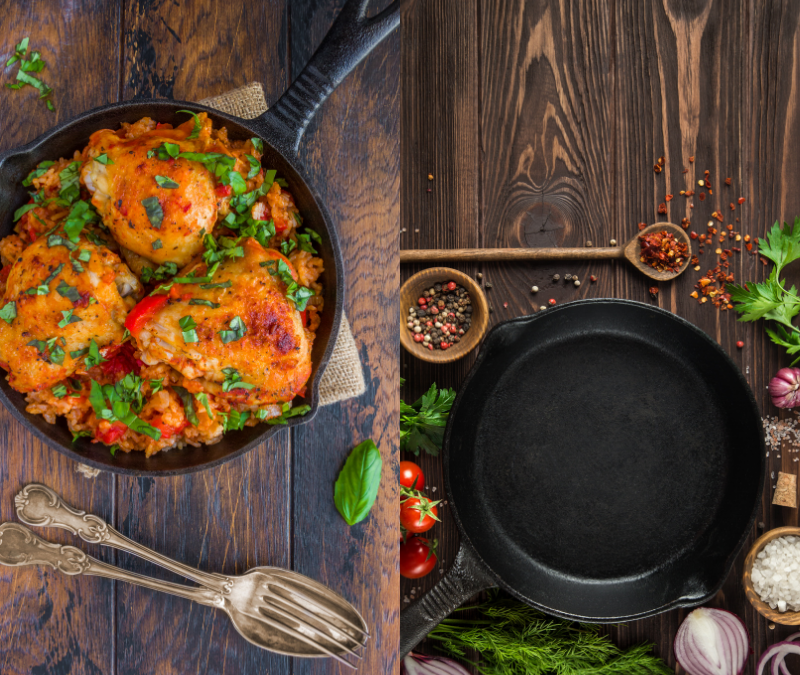History, Benefits, and Step-by-Step Guide
Welcome to our in-depth guide on how to clean a cast iron skillet! In this blog post, we’ll cover everything you need to know about maintaining your beloved cast iron skillet, including its fascinating history, the benefits of cooking with cast iron, and step-by-step instructions to keep it clean and in tip-top shape. Preparing food in cast iron is my personal favorite way to prepare food. I love the way it feels to cook with cast iron, and I think the food tastes richer and more flavorful. Let’s dive in!
The History of the Cast Iron Skillet
Cast iron skillets have a rich history that dates back centuries. Here’s a quick look at their origins and development:
- Ancient Origins: Cast iron cooking vessels were used by various ancient civilizations, like the Chinese, Romans, and Egyptians. However, the skillet shape as we know it today didn’t emerge until the Middle Ages.
- Medieval Europe: Skillets with flat bottoms and curved sides became popular in Europe during the Middle Ages. They were primarily used for cooking over open fires.
- Industrial Revolution: The Industrial Revolution in the 18th century brought advancements in cast iron production, making skillets more affordable and widely available.
- 19th Century: Cast iron skillet manufacturing continued to improve throughout the 19th century, leading to their widespread use in kitchens across Europe and America.
- 20th Century: While non-stick cookware gained popularity in the latter half of the century, cast iron skillets have experienced a recent resurgence due to their durability and versatility.
Benefits of Preparing Food in Cast Iron Skillets
Using a cast iron skillet offers several benefits that contribute to healthier and tastier meals. Here are some of the advantages:
- Iron Enrichment: Cooking with cast iron skillets can increase the iron content in your food, which is beneficial for individuals at risk of iron deficiency. Small amounts of iron leach into the food during cooking, especially with acidic or moisture-rich ingredients.
- Non-Toxic Cooking: Cast iron skillets are a natural and non-toxic option for cooking. Unlike some non-stick cookware, they don’t contain harmful chemicals like PFOA or PTFE.
- Even Heat Distribution: Cast iron provides excellent heat retention and distribution properties. It heats up evenly and maintains a consistent temperature, preventing hot spots and ensuring thorough cooking.
- Versatility: Cast iron skillets are incredibly versatile and can be used for various cooking methods, including stovetop, oven, and even grilling over an open flame. Their versatility eliminates the need for multiple cookware pieces and promotes sustainable cooking.
- Durability: Cast iron skillets are known for their durability. With proper care, they can last for generations, reducing the need for frequent replacement and minimizing waste.
- Some of my everyday cast iron skillets belonged to my grandmother. It is so satisfying to prepare scrambled eggs for my daughter in the skillet that my dad used to prepare eggs for me when I was young, and it is the skillet his mother used.
Step-by-Step Guide: How to Clean a Cast Iron Skillet
Now, let’s move on to the practical part – cleaning your cast iron skillet. Cleaning cast iron doesn’t need to be complicated. Follow these simple steps to keep it clean and well-maintained:
- Step 1: Cool down the skillet
- Make sure the skillet has completely cooled down before cleaning. Placing a hot skillet under cold water can cause it to warp or crack.
- Step 2: Remove any food residue
- Gently scrape off any stuck-on food particles using a spatula or non-metallic scraper. Avoid using metal utensils as they can damage the skillet seasoning.

- Gently scrape off any stuck-on food particles using a spatula or non-metallic scraper. Avoid using metal utensils as they can damage the skillet seasoning.
- Step 3: Rinse with hot water
- Rinse the skillet under hot running water. Use your hands or a soft sponge/brush to remove any remaining food debris. Be gentle to preserve the skillet’s seasoning.
- Step 4: Mild dish soap (optional)
- If the skillet is particularly greasy or has stubborn residue, you can add a small amount of mild dish soap to the hot water. However, it’s generally recommended to avoid soap as it can strip away the seasoning. Use soap sparingly and ensure it’s thoroughly rinsed off.
- Step 5: Dry the skillet
- Thoroughly dry the skillet using paper towels or a clean cloth. Moisture is the enemy of cast iron, so ensure it’s completely dry to prevent rusting. You can place the skillet on a stovetop burner over low heat for a few minutes to evaporate any remaining moisture. Alternatively, you can dry it in the oven by placing it upside down on a middle oven rack at around 200°F (93°C) for about 10 minutes.
- Step 6: Apply a thin layer of oil
- To maintain the skillet’s seasoning and protect it from rust, apply a thin layer of vegetable oil or specialized cast iron conditioner. Use a paper towel or cloth to rub the oil onto the skillet’s entire surface, including the handle and exterior. Remove any excess oil to prevent stickiness.
- Step 7: Store the skillet
- Once the skillet is clean and oiled, store it in a dry place. Avoid stacking other heavy items on top of it to prevent potential damage.
By following these steps, you can keep your cast iron skillet clean, well-seasoned, and ready for your next delicious meal!
In conclusion, cleaning a cast iron skillet is a simple process that ensures its longevity and optimal performance. With its fascinating history, numerous health benefits, and versatile cooking capabilities, the cast iron skillet continues to be a beloved kitchen companion. So, embrace the heritage and take good care of your cast iron skillet – it will reward you with many delightful meals for years to come!


